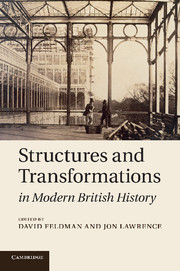Book contents
- Frontmatter
- Contents
- List of figures
- Notes on contributors
- Introduction: structures and transformations in British historiography
- 1 Coping with rapid population growth: how England fared in the century preceding the Great Exhibition of 1851
- 2 The ‘urban renaissance’ and the mob: rethinking civic improvement over the long eighteenth century
- 3 Forms of ‘government growth’, 1780–1830
- 4 Family formations: Anglo India and the familial proto-state
- 5 The commons, enclosure and radical histories
- 6 Engels and the city: the philosophy and practice of urban hypocrisy
- 7 The decline of institutional reform in nineteenth-century Britain
- 8 British women and cultures of internationalism, c.1815–1914
- 9 Psychoanalysis, history and national culture
- 10 Labour and the politics of class, 1900–1940
- 11 The dialectics of liberation: the old left, the new left and the counter-culture
- 12 Why the English like turbans: multicultural politics in British history
- Index
12 - Why the English like turbans: multicultural politics in British history
Published online by Cambridge University Press: 04 February 2011
- Frontmatter
- Contents
- List of figures
- Notes on contributors
- Introduction: structures and transformations in British historiography
- 1 Coping with rapid population growth: how England fared in the century preceding the Great Exhibition of 1851
- 2 The ‘urban renaissance’ and the mob: rethinking civic improvement over the long eighteenth century
- 3 Forms of ‘government growth’, 1780–1830
- 4 Family formations: Anglo India and the familial proto-state
- 5 The commons, enclosure and radical histories
- 6 Engels and the city: the philosophy and practice of urban hypocrisy
- 7 The decline of institutional reform in nineteenth-century Britain
- 8 British women and cultures of internationalism, c.1815–1914
- 9 Psychoanalysis, history and national culture
- 10 Labour and the politics of class, 1900–1940
- 11 The dialectics of liberation: the old left, the new left and the counter-culture
- 12 Why the English like turbans: multicultural politics in British history
- Index
Summary
Exclusion
One day in June 1967, Tarsem Sandhu, a 23-year-old Sikh living in Wolverhampton, turned up for work as a corporation bus driver. He had been at home unwell for the previous three weeks and during that period he had decided to dedicate himself more determinedly to Sikhism. Kesh – uncut and knotted hair – is one of the five symbols of Sikh identity introduced by Guru Gobind at the end of the seventeenth century. Accordingly, Sandhu now refrained from shaving and from cutting his hair. By the time he returned to work he was wearing both a turban and a beard. Although Sandhu's appearance conformed to Sikh prescription, his turban departed from the regulation uniform prescribed for bus drivers by the Wolverhampton Transport Committee and his beard transgressed an informal agreement between the local branch of the Transport and General Workers Union and the Committee that employees should be clean-shaven. Sandhu's manager immediately suspended him from work without pay.
The ban on Wolverhampton bus crews wearing beards and turbans initiated a two-year-long dispute that reverberated far beyond the town itself, both in Britain and India. The Sikhs' repertoire of protest involved lobbying and letter-writing as well as public demonstrations. The visible high point of their campaign occurred in March 1968 when 4,000 Sikhs marched silently through Wolverhampton. They were opposed by Wolverhampton Corporation and by its transport committee in particular, by managers in the corporation's transport department, as well as by the local leadership of the Transport and General Workers Union.
- Type
- Chapter
- Information
- Structures and Transformations in Modern British History , pp. 281 - 302Publisher: Cambridge University PressPrint publication year: 2011
- 12
- Cited by

